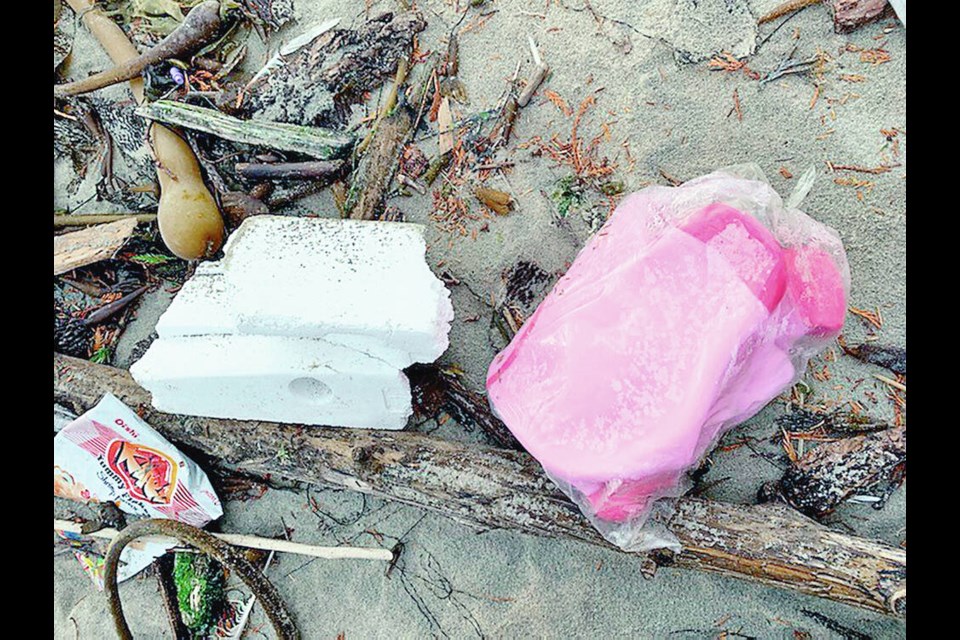Volunteers are collecting debris from broken shipping containers that is washing up on northern Vancouver Island beaches, even though they’ve been told they are not needed.
“You can’t really stop good people from trying to help when it’s this big of a disaster,” Ashley Tapp of Port McNeill said Tuesday. “We’re still going to go check on the beaches that we usually clean.”
Tapp, co-founder of the non-profit Epic Exeo, which carries out regular beach cleanups, said it can take hours to reach some of the remote and rugged beaches via vehicle, and then a hike to the shore to do cleanup.
Items found include car armrests, headrests, floor mats and plastic air pumps that likely came from the Zim Kingston, she said.
The container ship lost 109 containers overboard off the west coast of Vancouver Island during rough weather on Oct. 22. So far only four containers have been found on shore.
A day later, the ship moored close to Victoria, where a fire broke out that has since been extinguished. The ship remains at Constance Bank.
The Canadian Coast Guard posted a message on social media saying it’s not looking for volunteers to collect debris, adding all container-debris-recovery efforts are being co-ordinated with the ship owner’s contractors through the incident command post, a multi-agency group set up to co-ordinate the response. All levels of government, including First Nations, and the private sector are taking part.
Tapp said her group and other environmental groups are working together to clean up beaches that the contracted crew is not focusing on. “There’s a lot of coastline to cover here. And so that’s where a few of our local non-profit organizations are going to just go and head out there and start cleaning.”
Eco Exeo sends marine debris to the Lower Mainland where specialists deal with it, said Tapp, adding volunteers can contact her organization for help disposing of marine debris.
She expects that as metal in sunken containers erodes, they will break open and their contents will spill into the ocean.
The Zim Kingston situation prompted a group of seven NDP MPs, including six from the Island, to send a letter to new federal Fisheries Minister Joyce Murray this week, saying the government needs a tactical response team and plan for incidents like the container-ship spill, adding the current shipper-led response strategy is “simply not working.”
While the short-term focus is ensuring the spill is fully cleaned up, in the longer term, the government needs to look at the regulations under which ships operate to ensure “Canada is doing everything it can to protect our coastal environment from these kinds of incidents,” said Taylor Bachrach of the Skeena-Bulkley Valley riding.
The MPs are Rachel Blaney for North Island-Powell River, Gord Johns for Courtenay-Alberni, Lisa Marie Barron for Nanaimo-Ladysmith, Alistair MacGregor for Cowichan-Malahat-Langford, Randall Garrison for Esquimalt-Saanich-Sooke and Laurel Collins for Victoria. They are offering local knowledge and connections to help deal with the container situation.
Their letter said that only small sections of the affected coastline have been cleaned, and the timeline and plan are unclear for recovering debris on the shorelines between Cape Sutil, at the northern tip of the Island, and Cape Scott, to the west.
“This is particularly galling when there are local groups with extensive experience and knowledge of coordinating shoreline cleanup efforts in this area and have skilled and experienced workers with WorkSafeBC certification and knowledge of the terrain to implement emergency recovery plans with immediate effect. There, as yet, appears to be no intention by the government or the shipping company to engage them.”
On Tuesday, Danaos Shipping Co., which manages the Zim Kingston, said the vessel is stable and a transit plan has been submitted to federal authorities for review.
The remaining containers on the vessel are safe and will be unloaded once a port of call has been identified, it said.
Specialized marine contractors hired by the company have been removing containers and debris from shores. The cleanup process consists of helicopter crews airlifting larger pieces, while teams on foot comb the beaches for small debris, the company said.



